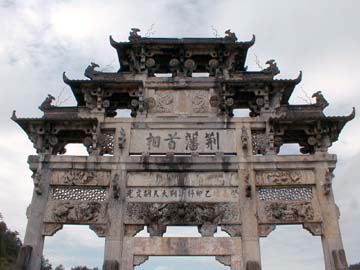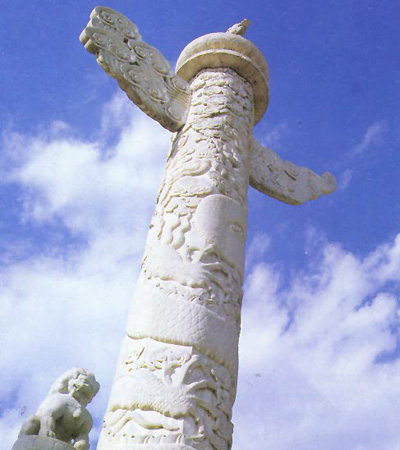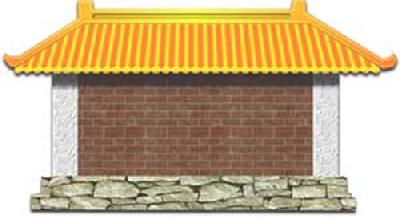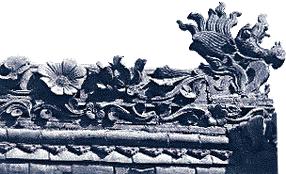
 Que
Que
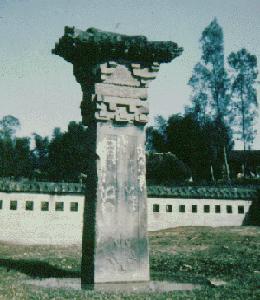
Que was a kind of architecture in ancient China usually erected at the entrance of landmark structures, such as palaces, mansions, temples and mausoleums, etc. It was originally built for watch and ward, but later developed into decretive architecture, to give prominence to the stateliness and high status of the structure. Generally, Que falls into the following three types:
1. Watchtower on either side of a palace gate
2. Decretive carvings in front of aristocratic mansions
3. Stone carvings erected in front of a temple or tomb, usually engraved with such relievos as human figures, beasts, legendary animals, etc.
 Paifang
Paifang
|
|
Paifang, also called Pailou in Chinese, is very Chinese architecture. Actually, a Paifang is an archway usually made of fine wood or stone, well painted and with glazed tiles sometimes, for memory and decoration. On its middle beams, moral inscriptions by certain calligraphist, mostly preaching some norms, often can be seen. Usually, these so-called memorial structures stand in downtown areas, or before entrances of mausoleums, temples, bridges and parks.
Paifang or Pailou reflects people's life aspirations in feudal times, which usually can be read from inscriptions on the beams. It exhibits folk customs of ancient China. The sacred emotions of the ancient Chinese rested on Paifang too. Erecting a Paifang was a very solemn event. Various emotions, praising, honoring, commemorating, praying or blessing were materialized through those beautiful arches. The structure mirrors feudal ethics and traditional norms in ancient China. As a physical architecture of those ethics and norms, various Paifangs, such as chastity Paifang (mostly for widowed women exclusively), loyalty Paifang and filial piety Paifang, were set up all around.
Paifang witnesses history. Many a Paifang was built to commemorate historical events and important historic figures, thus those structures are of great importance in the research of Chinese history.
Though Paifang is deemed as memorial architecture, it has other functions -- marking, decorating, honoring and spacing.
Paifang has long become a symbol of China for its long history, rich connotation and unique art value. It presents perfect harmony of ancient Chinese architectural modeling art and sculpting art.
 Huabiao
Huabiao
|
|
Huabiao, as something typically Chinese, is actually an ornamental or symbolic column erected in front of palaces, bridges, city gates, tombs or other places. They used to be made of wood, hence their other name -- Huabiao Mu. They were difficult to preserve, however, and the Haubiao we see today are mostly made of marble.
Originally, Huabiao functioned originally as a road sign. At the same time they were also used by people to record criticism against the king and ministers. Hence, it was also called Feibang Mu, or wooden column for criticism.
Huabiao emerged long before the Qin Dynasty (221-206BC). With the establishment of monarchical power, Huabiao's function as a criticism media faded, and it also no longer played its role as a road sign. Instead, with carving of dragons and auspicious clouds, it became a pure ornament erected in front of buildings.
China has many Huabiao left today, but the most distinguished are the two inside and outside of Tian'anmen Gate. Made of marble and carved with dragons and auspicious clouds, each has a Wangtianhou, a legendary animal, sitting on it.
The one on top of the column inside the gate is named Wangdigui (literally, expecting the emperor to come back soon), implying that the emperor should not stay long outside the palace enjoying the beautiful mountains and water, but should come back soon to deal with state affairs. The one on top of the column outside the gate, with its head turned to the outside, is named Wangdichu (expecting the emperor to go out), indicating that the emperor should not indulge himself in the luxurious life inside the palace, but should go our frequently to keep abreast of public sentiment.
 Yingbi
Yingbi
|
|
Yingbi, known as a "screen wall" in English, is the isolated wall either outside or just inside the gate of a traditional Chinese house to shield the rooms from outsiders' view. It is also called Zhaobi or Zhaoqiang in Chinese. It can be made of any material-brick, wood, stone or glazed tile.
The yingbi dates back at least to the Western Zhou Dynasty (11 century-771 BC). In ancient times, the Yingbi was a symbol of rank. According to the Western Zhou system of rites, only royal palaces, noblemen's mansions and religious temples could have a screen wall. Apart from keeping passers-by from peeping into the courtyard, the screen wall could also be used by the visitor, who would get off from his carriage and, standing behind the wall, tidy up his dress before going in. It was not until much later that private houses (mainly the quadrangles of bungalows in the northern parts of the country) began to have screen walls.
The most exquisite of all ancient screen walls are three "nine-dragon walls" built of glazed color tiles. The largest of these, 45.5m X 8m X 2.02m, is now in the city of Datong, Shanxi Province. It originally stood in front of the princely mansion of the thirteenth son of Zhu Yuanzhang, first emperor of the Ming Dynasty (1368-1644). Sculpted on it in seven different colors are nine dragons flying in clouds. The most splendid of the three is the one which belonged to a palace of the Ming Dynasty and now stands north of the lake in Beijing's Beihai Park. It is a mosaic of glazed color tiles showing on each side nine curly dragons in relief. An observant visitor could also count 635 dragons of smaller sizes on the ridges and roof tiles of the wall. The third of these walls stands opposite the Huangji Gate in the Forbidden City and is well-known to sightseers. All the three mentioned above were built during the Ming Dynasty and all used to stand in front of the entrance to a courtyard, making a component part of the architectural complex and adding to the magnificence of the buildings.
There is a screen wall in each of the side palace courtyards of the Forbidden City. Whether made of wood, carved out of marble or built with glazed tiles, it is invariably a fine piece of work with designs symbolic of good luck.
In the vicinity of the Five Dragon Pavilions (Wulongting) in the Beihai Park of Beijing, there is a so-called "iron screen wall," a relic from the Yuan Dynasty (1271-1368) of the thirteenth century. At first glance, it appears to have been cast of iron but actually it is a piece of volcanic rock. Carved on it in vivid style are, on one side, lions playing with a ball and, on the other, a legendary unicorn; it is noted for its antiquity and simplicity of execution.
 Zoomorphic Ornaments
Zoomorphic Ornaments
|
|
Chinese palaces, temples and mansions have on their roofs a special kind of ornaments called Wenshou or zoomorphic ornaments, some on the main ridges and some on the sloping and branch ridges.
The monstrous thing at either end of the main ridge, called Chiwen, appears roughly like the tail of a fish. Fierce and formidable, it looks as if it were ready to devour the whole ridge; so it is also known as Tunjishou or the ridge-devouring beast. It is, according to Chinese mythology, one of the sons of the Dragon King who rules the seas. It is said to be able to stir up waves and change them into rains. So in ancient times, a Chiwen was put at either end of the main ridge to conjure up downpour to put out any fire that might break out. But for fear that it might gobble up the ridge, ancient Chinese transfixed it on the roof with a sword.
At the end of the sloping and branch ridges there are often a string of smaller animals, their sizes and numbers being decided by the status of the owner of the building in the feudal hierarchy.
The largest number of zoomorphic ornaments is found on Taihedian (the Hall of Supreme Harmony) of the Forbidden City. Leading the flock is a god riding a phoenix, after whom come a dragon, a phoenix, a lion, a heavenly horse, a sea horse and five other mythological animals, all called by unusual names. Qianqinggong (the Palace of Heavenly Purity), which the emperor used as his living quarters and his office for handling daily affairs, being next in status to Taihedian, has a band of nine animal figures. Still next in importance is Kunninggong (the Palace of Female Tranquility), which served as the empress's apartments; it has a group of seven zoomorphic figures. This number is further reduced to five for the twelve halls in side courtyards that used to house the imperial concubines of different grades. Some of the side halls have only one animal figure each on their roofs. These small animals were also believed to be capable of putting out fires.









